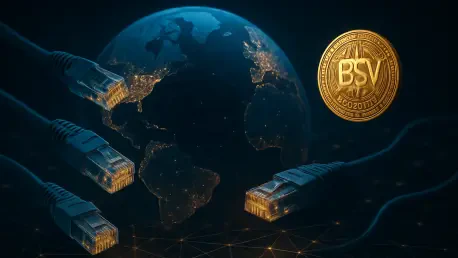Imagine a digital landscape where every interaction—be it a click, a view, or a data share—translates into immediate economic value for creators and users alike, bypassing cumbersome intermediaries and monopolistic platforms that dominate today’s internet. This transformative idea lies at the heart of Calvin Ayre’s vision, a tech innovator who is harnessing the power of the Bitcoin SV (BSV) blockchain to fundamentally reshape how the online world operates. Through the concept of the Metanet, Ayre seeks to weave financial incentives directly into the internet’s infrastructure, tackling persistent challenges such as unfair compensation for content creators and the overwhelming control exerted by centralized tech giants over data and services. This isn’t merely a technological tweak but a profound reimagining of the digital economy, promising a system where value flows seamlessly and equitably. Ayre’s background as an early internet trailblazer, notably through founding Bodog, underscores his knack for spotting and capitalizing on emerging trends well ahead of the curve. Having shifted focus to blockchain technology a decade ago, his mission now is clear: to address the internet’s structural flaws and build a more inclusive, value-driven online ecosystem that could redefine user experiences and business models for years to come.
The Technological Backbone of a New Internet
Unleashing Scalability with BSV
At the core of the Metanet vision is the remarkable scalability offered by the Bitcoin SV blockchain, a critical factor in making this ambitious overhaul of the internet feasible. The Teranode project, a key development in BSV’s evolution, has achieved transaction processing speeds exceeding 1.1 million per second—a figure that dwarfs the capabilities of traditional blockchains and even conventional financial systems. This isn’t just a technical milestone; it represents the foundation for an entirely new digital economy where transactions of minuscule value can occur instantly and at scale. Such capacity is vital for enabling models like micropayments, where users might pay mere fractions of a cent to access content, ensuring creators are compensated directly without the inefficiencies of advertising or subscription frameworks. This scalability addresses one of the internet’s longstanding pain points: the inability to handle small, frequent transactions economically. By doing so, BSV positions itself as a viable infrastructure for a future where every digital interaction can carry inherent economic value, fundamentally altering how content and data are monetized online.
Pioneering New Economic Models
Beyond raw speed, the scalability of BSV unlocks innovative economic possibilities that could transform user interactions in the digital realm. Imagine a scenario where artificial intelligence systems autonomously buy and sell verified data in real time to enhance their training processes, or where Internet of Things (IoT) devices engage in direct, machine-to-machine transactions without human intervention. These concepts, once relegated to speculative discussions, are now within reach thanks to the robust infrastructure BSV provides. Micropayments stand out as a particularly impactful application—users could pay tiny amounts for individual articles, videos, or even specific data insights, with funds going straight to creators, bypassing the ad-driven models that often undervalue content. This shift could empower a new wave of independent creators and businesses by ensuring fairer revenue distribution. Additionally, the integration of IoT with blockchain opens up avenues for automated economies, such as smart devices negotiating energy usage or service fees independently. These use cases highlight how the Metanet could foster a more dynamic and inclusive internet, reducing dependency on outdated monetization systems and paving the way for novel interactions.
The Enterprise Edge of BSV
A Business-First Approach
Unlike many cryptocurrency initiatives that chase retail investor hype, the strategy behind Bitcoin SV focuses squarely on enterprise adoption, targeting industries where blockchain’s unique attributes can deliver tangible benefits. Sectors such as supply chain management, digital identity verification, and financial auditing stand to gain immensely from the immutable, transparent record-keeping that BSV offers. For instance, in supply chains, blockchain can ensure traceability of goods from origin to destination, reducing fraud and enhancing trust among stakeholders. Similarly, digital identity solutions built on BSV can provide secure, verifiable credentials that streamline processes in industries like healthcare or finance. This enterprise-centric approach isn’t about chasing quick financial gains through speculative trading; rather, it’s about embedding blockchain as a reliable, long-term solution within business operations. By prioritizing practical utility over fleeting market trends, this strategy aims to establish BSV as a cornerstone of modern industrial infrastructure, addressing real-world challenges with measurable outcomes that businesses can depend on.
Regulatory Alignment as a Strength
A distinguishing feature of the BSV approach is its unwavering commitment to regulatory compliance, setting it apart from numerous cryptocurrency projects that have stumbled into legal quagmires due to their disregard for established frameworks. By aligning with governmental and industry standards, BSV positions itself as a trustworthy tool for enterprises navigating complex legal environments. This focus on compliance isn’t merely a defensive tactic; it’s a strategic advantage that builds credibility with businesses and policymakers alike. Instead of branding itself as a speculative asset, BSV is framed as an enterprise-grade blockchain designed to solve practical problems, from data integrity to transaction transparency. This deliberate positioning helps mitigate the risks of regulatory backlash that have hampered other digital currencies, ensuring that businesses adopting BSV can do so with confidence. Such alignment also facilitates partnerships with regulated industries, where auditability and adherence to rules are non-negotiable. By prioritizing a lawful and transparent operational model, BSV seeks to become a foundational technology that integrates seamlessly into existing systems while fostering trust across diverse sectors.
Global Strategy and Technological Sovereignty
A European Tech Powerhouse
Ayre’s vision for the Metanet extends into the geopolitical arena, with a strategic emphasis on positioning Bitcoin SV as a technology rooted in European innovation and values. This approach directly addresses growing concerns about over-reliance on American tech giants that dominate much of the global digital landscape. By tailoring BSV applications to comply with European regulatory frameworks and partnering with local entities, the initiative aims to bolster technological independence for the region. This isn’t solely a business maneuver; it’s a calculated effort to provide European nations with a competitive edge in the rapidly evolving digital economy. The focus on Europe taps into broader discussions about data privacy, security, and regional control over critical infrastructure, aligning BSV with priorities that resonate deeply with policymakers and businesses in the area. Such positioning could accelerate adoption by presenting BSV as a homegrown solution that champions European interests, potentially reshaping how digital infrastructure is perceived and developed across the continent.
Balancing Digital Dominance
The push for technological sovereignty through BSV reflects a larger global imperative to diversify control over digital ecosystems and reduce dependency on a handful of dominant players. By establishing itself as a viable alternative, BSV challenges the status quo of U.S.-centric internet systems that often dictate terms to other regions. This strategy involves creating applications and partnerships that cater specifically to non-American markets, ensuring that the technology addresses local needs and regulatory nuances. The broader goal is to foster a more balanced digital landscape where regions can exert greater influence over their technological futures, safeguarding against vulnerabilities that arise from concentrated power in tech infrastructure. This geopolitical dimension adds a layer of significance to the Metanet vision, framing it as not just a technological innovation but also a catalyst for redefining global digital equity. By advocating for decentralized control and regional empowerment, BSV aims to contribute to a more resilient and diverse internet framework that benefits a wider array of stakeholders worldwide.
Shaping the Future of Digital Interaction
Reflecting on a Visionary Shift
Looking back, the ambitious blueprint laid out by Calvin Ayre through the Metanet and Bitcoin SV blockchain marked a pivotal moment in the discourse on internet infrastructure. The emphasis on embedding economic incentives directly into digital protocols addressed critical flaws in how value was distributed online, offering a glimpse into a more equitable system. The scalability achievements of projects like Teranode, alongside a steadfast commitment to enterprise solutions, demonstrated a path forward that diverged sharply from the speculative frenzy of other digital currencies. Moreover, the strategic focus on regulatory compliance and geopolitical relevance, particularly in Europe, underscored a nuanced understanding of the barriers to mainstream adoption. These efforts collectively painted a picture of a technology that was not just innovative but also pragmatic, tailored to meet the demands of a complex, interconnected world.
Charting the Next Steps
Moving forward, the success of this transformative vision hinges on sustained efforts to showcase tangible benefits to businesses and creators who stand to gain from a restructured internet. Collaborations with industries to pilot micropayment systems and IoT integrations could serve as proof points, encouraging wider adoption. Additionally, continued alignment with regulatory bodies will be essential to maintain trust and facilitate integration into existing frameworks. Expanding educational initiatives to demystify blockchain’s potential for non-technical stakeholders might also accelerate acceptance. As challenges like network effects and transition costs persist, focusing on incremental, value-driven implementations could pave the way for broader acceptance, ensuring that the Metanet evolves from a visionary concept into a cornerstone of tomorrow’s digital economy.









